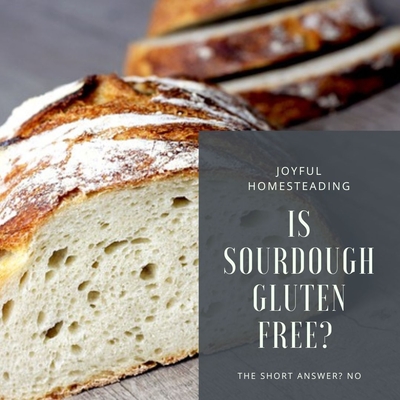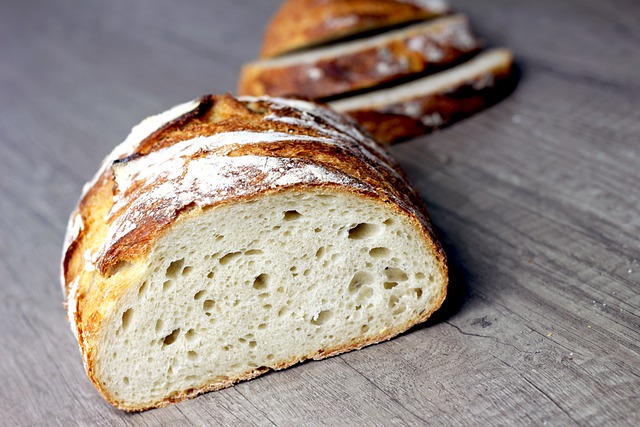Is Sourdough Gluten Free?
Is sourdough gluten free? The short answer is no. If you have a severe gluten allergy, stay away from wheat altogether, including sourdough bread.

If you’re sensitive to gluten, make this great gluten-free sourdough bread instead. If you simply want to cut back on gluten, however, and can’t bear the thought of giving up bread, sourdough bread might be a great option for you.
What Is Sourdough Bread?
Sourdough bread is different from other types of bread because it uses fermentation as leavening. While regular bread uses packaged yeast, sourdough bread rises because of the Lactobacillus bacteria it contains with other wild yeasts.
Why Is Sourdough Gluten Free?
When making sourdough bread, the dough must rest in a warm location for eight hours or overnight. During that time, healthy bacteria digest the dough’s starches, producing lactic acid and carbon dioxide.
Lactic acid makes the bread more nutritional. It also can help prevent many health problems, including intestinal infections, reduce harmful cholesterol levels, and even ward off some types of cancer.
I have wheat allergies, but I’ve found that so long as I consume kombucha and other fermented foods on a regular basis, I can safely eat sourdough bread from time to time. It’s a delicious, occasional treat for me. Sourdough bread has a light texture and a tangy sour flavor that’s hard to resist.

Why Make Sourdough Bread?
So why make this tangy bread? Although it does involve some planning, you’ll find it’s not only doable but pleasant to make your own sourdough bread. Here are some reasons you should invest in a good-quality, sourdough starter and keep it alive.
1. Sourdough Bread Is Easier To Digest
Fermented foods, including sourdough bread, are easier to digest. The fermentation process breaks down many of the starches and proteins found in wheat. Even if you can eat regular wheat bread, switching to sourdough may be a wise choice for you and your family.
2. Fermented Foods Build Up Your Immune System
Your body fights viruses in both your lungs and your gut. People swallow bad bacteria that cause disease every day. The good bacteria in your intestines lower the pH balance in your gut and secrete proteins that kill the bad bacteria.
The good bacteria also produce the vitamins your body needs to fight illness, including many crucial B vitamins. Eating fermented foods, including sauerkraut and kimchi, and drinking kombucha and kefir will build up the healthy bacteria in your gut.
3. It's a Part of History
Sourdough bread is one of the oldest types of naturally leavened bread in history. Egyptians used to make sourdough bread. It relies on wild yeast, a living microorganism you find all around you. Using a sourdough starter, you’ll capture that wild yeast, and that, in turn, makes the bread rise and enables fermentation.
The pioneers took sourdough with them to add flavor to their bread and make it rise. Sourdough got a particular tang in San Francisco that is still popular today. And the prospectors took their sourdough starter north to Alaska, baking their bread in Dutch ovens.
4. It’s a Self-Reliant Way To Have Bread in an Emergency
If you can handle wheat, making sourdough bread regularly is a smart way to ensure you’ll have bread in an emergency. By having your own sourdough starter, you’ll always be able to make a healthy loaf of bread even when you can’t run to the store for yeast.
Store wheat so you can always make bread. Then use this recipe for the best sourdough bread you make at home. This recipe is from Cultures for Health. You’ll need to purchase the sourdough starter and prepare it before using this recipe.
- 2 1/3 cups sourdough starter
- 3 1/3 cups flour
- 1 to 1 1/2 cups of water
- A little less than 1 tablespoon of salt
Mix together the sourdough starter, flour, and salt. Then add enough water to make a moist bread dough. Knead the dough until a small piece of it can stretch the length of four fingers before it breaks.
Shape the dough into a loaf and then place it in a pan. Rub oil on the top of the dough and cover with a towel. Allow the dough to rise between 4 and 24 hours. Use a sharp knife to slash an X-shape on the top of the loaf. Then bake it at 400 degrees Fahrenheit for 30 to 60 minutes, until the bread’s internal temperature reaches 210 degrees Fahrenheit. You can insert a meat thermometer into the side of the loaf to check its internal temperature. Allow the bread to cool completely before slicing.
Why Is sourdough Gluten Free so Important?
With food instability being what it is, it's crucial to have food on hand that you can rely on in case there is runaway inflation or you can't go to the store. Learn more about storing food here.










New! Comments
Have your say about what you just read! Leave me a comment in the box below.